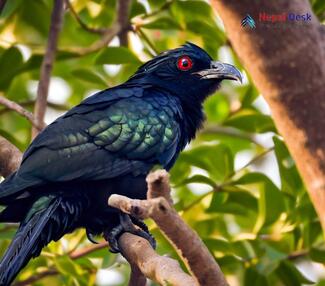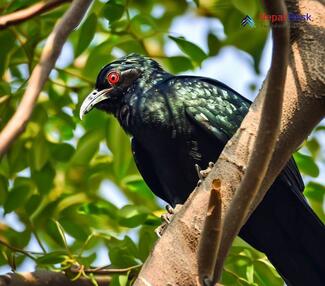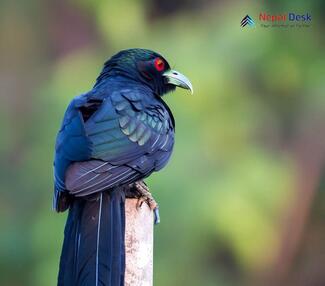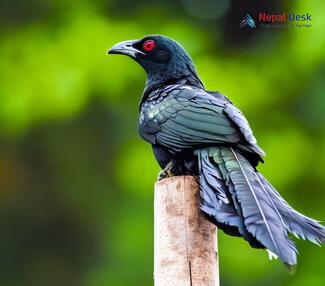The Asian Koel (Eudynamys scolopaceus) is a member of the cuckoo family Cuculidae. This brood parasite breeds across tropical southern and southeast Asia from India to southern China and down into Malaysia and Indonesia. Known for the loud "koel" call of the male, this vocal bird has permeated the cultures of lands where it dwells. In Nepal in particular, the Asian Koel holds special meaning, being revered for its singing which marks the coming of spring after the cold winter months.
The arrival of the Asian Koels in Nepal, which breed there during the hot pre-monsoon months before returning south for the winter, has long been celebrated in Nepali culture. Their distinctive calls permeate village and city soundscapes. Featured in folk songs and poems, the koel's presence signifies rebirth and regeneration to the primarily Hindu and Buddhist inhabitants of the Himalayan country.
As a topic rich in biological interest and cultural symbolism in Nepal, the Asian Koel offers much to explore regarding the intertwining of nature and human societies. Delving into geographical spread, annual migratory patterns synchronized with seasonal shifts, evolutionary adaptations like brood parasitism, and the interplay of a bird's niche with the belief systems of human populations, this vocal migrant bird provides a fascinating lens through which to examine the natural world.
Taxonomy and Description
The Asian Koel possesses features typical of the Cuculidae, or cuckoo family of birds. Scientifically named Eudynamys scolopaceus, “scolopaceus” references its slight resemblance to the long-billed sandpiper, a type of shorebird called Scolopacidae.
Within the genus Eudynamys, the Asian Koel is most closely related to the Pacific Koel (E. orientalis) and Black-billed Koel (E. melanorhynchus). Its genus name “Eu-dynamys” derives from Greek, meaning “true” and “powerful,” referring to their loud calls. Among features characterizing Asian Koels are long tails, small feet, and particularly curved slim bills that aid their diet of fruit and insects.
Sexual dimorphism distinguishes the two sexes. The male has glossy bluish-black plumage and blood-red eyes, contrasting sharply with the brownish-gray head, body, wings, and tail of the female. Females also possess white speckles on their wings. In both sexes, juveniles have a duller, more mottled appearance until their mature definitive plumage emerges after the first year.
Overall a medium-sized cuckoo at roughly 30 cm long and weighing 100 grams, the Asian Koel’s most remarkable feature is unarguably its resonating call. The “koel” vocalization of males gives the species its common name across South and Southeast Asia.
Global Distribution and Habitat
The Asian Koel is distributed widely across much of South, Southeast, and East Asia. Its native breeding grounds span from the Indian subcontinent covering India, Pakistan, Bangladesh, and Sri Lanka, across Myanmar, Thailand, and southern China, down through Malaysia and Singapore to the islands of Indonesia. A highly migratory species, Asian Koels make long annual journeys south from their northern breeding ranges to their wintering areas across the tropical parts of their range.
This natural spread has been supplemented by the introduction of breeding populations in some regions of Australia, as well as Pacific islands like Hawai‘i. These non-native populations were established through a combination of birds that escaped from captivity or were intentionally released. Issues of Asian Koels becoming invasive pests have emerged in parts of their introduced Australian range.
Across its native tropical and subtropical habitat, the Asian Koel inhabits a diverse array of wooded land across both rural and urban areas, including lightly forested regions, parks and gardens, agricultural areas, and river corridors. They require an abundance of fruiting trees that form the basis of their diet. The ability to thrive across disturbed, cultivated habitats has allowed them to adapt to deforestation and habitat fragmentation in much of their range.
As a brood parasite reliant on the nests of other species to raise offspring, the Asian Koel conversely requires adequate densities of suitable avian nesting hosts, particularly crows and mynas which predominantly receive koel eggs. This complex relationship between host distribution and koel breeding success constrains their abundance despite their flexibility in inhabiting human-modified environments.
Behavior and Ecology
The Asian Koel exhibits a range of behaviors and adaptations that enable its widespread success. A fruit-eating specialist, the koel’s diet primarily consists of a variety of wild and cultivated fruits, supplemented by some insects and larvae. Their morphology features traits suited to fruit consumption - curved bills efficient at extracting flesh, robust intestinal tracts to process abundant fiber, and perching feet rather than grasping talons. Studies of fecal samples confirm over 90% of fruit composition.
Most remarkably, the Asian Koel practices obligate brood parasitism, laying eggs exclusively in the nests of other bird species to raise its young. They most frequently target abundant species in the crow and starling family which provide good foster parents. After a female koel opportunistically deposits an egg, the unsuspecting hosts incubate the koel egg and feed the hatched chick as their own, despite its larger size and abnormal appetite exceeding their offspring. This provides a highly efficient breeding strategy as the koels invest minimal energy in rearing offspring themselves.
Ecologically, the koels may help to limit the population densities of common host species that compete for similar fruit resources. Dispersing seeds contained in regurgitations and feces of their fruit-heavy diets also positively interact with favored fruiting tree distributions that interdependently support koel populations. Their migratory habits also contribute to significant seasonal shifts in biomass and resources. Overall as abundant seasonal migrants tied to specific climate windows and host availability, Asian koels represent an influential component of ecosystems and indicator species for habitat stability across their endemic Asian zones.
Vocalization and Communication
The Asian Koel is far better known for its persistent vocalizations than its visual appearance. Of particular significance are the loud, ringing calls of the males, most famously a repetitive “koel” sound that gives the bird its common name. These distinctive vocalizations play a key role in the species’ breeding behavior.
Male koels begin broadcasting their courtship calls to attract mates at the start of each breeding season. The resonance and repetition of their calls allow sound to carry over long distances, communicating fitness and territorial dominance to rival males while drawing in fertile females across broad areas. Once a female joins a male, pairing is reinforced through call-and-response duets between mates.
Beyond territorial defense and courtship, the timing of Asian koels’ seasonal vocal outbursts indicates their arrival and departure across their migratory range, penetrating the soundscapes of rural villages and urban city parks alike. Asian poets have waxed poetic about welcoming the koel’s song as a harbinger of spring. These seasonal cycles fuel significant cultural connections, especially in the koels' Indian subcontinent homeland where Hindu astrology even marks its appearance on the lunar calendar.
In few places though have the vocalizations of the migrant koels become more engrained within folklore and spiritual belief than in Nepal, where koels have become interwoven with Newari and Nepali identity. The males’ resonant spring calls stir farmers to action, while also carrying philosophical and religious symbolism of renewal and time’s passage in the Himalayan culture.
Reproduction and Lifecycle
The Asian Koel's breeding season commences across tropical southern Asia timed with the pre-monsoon months from March to August when fruit abundance peaks to feed its offspring. However, koels do not construct their nests. Instead, the species persists through obligate brood parasitism.
After mating with male koels drawn in by courtship calls, female koels proceed to lay eggs surreptitiously in the nests of other bird species, favoring abundant tree-dwelling hosts like crows and mynas. She deposits up to 15 whitish-brown speckled eggs over just days in nests she finds opportunistically in her territory, often damaging some existing eggs to induce the host parents to nurture the remaining eggs. Despite substantially larger koel hatchlings and voracious appetites, the unsuspecting hosts invest full effort in rearing the young koels often at the expense of their chicks.
This effective breeding strategy concentrates parental investment into mating rather than childcare as the hosts bear the energy costs of nest construction and feeding offspring. Within weeks, the juvenile koels fledge and become independent, while host species attempt to rebuild nests and breed again. After reaching maturity in one year, koels migrate south to warmer climates for the winter non-breeding season before commencing courtship and parasitic breeding again the following spring in a cyclical pattern through adulthood.
In places like Nepal, this reproductive dependence specifically on locally common species makes sustaining viable host abundances vital to koel breeding success. Their cultural fame acknowledges an intertwined coexistence though sometimes still strained by disruptive nest takeovers. Overall the koels’ unusual lifecycle spotlights complex symbiotic relationships enabling the evolution of brood parasitism predilections.
Relationship with Humans
The loud calls and conspicuous behaviors of the migrating Asian Koels have made the birds culturally meaningful across their home ranges. Aboriginal Australians even consider the Koel a totem bird in traditional lore. But the species exerts especially strong cultural resonance across the Indian subcontinent infusing vernacular languages, poetry, song, astrology, and Hindu/Buddhist spiritualism.
This significance permeates daily rural life during the frenzied spring breeding periods which overlaps the cultivating of rice and millet, as beliefs suggest hearing koels brings rains for irrigation and competence in tending fields. Accordingly, popular adages translate to phrases like “mad as a koel” alluding to the passionate intensity with which the birds pursue mating. Koel motifs commonly decorate fabrics and crafts as icons of love and fertility.
Literary works reference the koel from ancient Sanskrit texts onward including fables attributing cunning characteristics to the brood parasites. Most prolific are odes glorifying the koel's vocal exuberance as poetic metaphors, such as Kalidasa’s 4th century Meghaduta in which a banished yaksha demigod sends verbal messages by a passing cloud thus described: “Carry my missive to... woods resonant with peacock calls, cuckoo songs and the sweet plaintive wails of lovesick kokila.” Here the onomatopoeic word kokila captures the phonetic koel cry in Hindi.
Indeed the themes of seasonal renewal and temperate climates heralded by the migratory koels’ arrival have deeply resonated with Subcontinental sensibilities and contributed profoundly to disseminating the birds in folklore which still prominently continues in modern-day Nepal.
The Asian Koel in Nepal
Of all the regions across the vast range of the Asian Koel, no place has cultivated a closer cultural affinity than Nepal for these loud migratory cuckoos. More than just the national bird stamped on currency notes and postage stamps, the koel holds deep meaning for the majority of Hindu and Buddhist citizens of the Himalayan country.
The very timing of koels sweeping across terai grasslands into Nepali hills and valleys during Spring coincides with the festival of Biska Jatra which celebrates Nepali New Year in mid-April and the return of milder weather. Their resonant calls permeate city spaces to remote farmlands, marking renewal and fertility metaphors for rice cultivation. Beliefs suggest koel song even stimulates rainfall critical to crops.
Beyond religious connotations, koel cries ringing out across terraced foothills also carry practical utility for Nepal's large agrarian sector. Cues of koels commence planting cycles for staples like millet and maize before the monsoon rains arrive for tropical Nepali climate zones. The interplay of koel breeding and cycles of harvests highlights deep ecological ties between the birds and human inhabitants.
These bonds mix spiritual philosophy about impermanence and karma with livelihoods sustained through intimate reliance on local ecology and climate, fused in the form of the opportunistic brood parasite Eudynamys scolopaceus. As Nepal modernizes, the preservation of these traditions remains crucial to upholding the cultural identity shaped by the Asian Koel. The koels in turn indicate the stability of a balanced ecosystem supporting both endangered wildlife and human communities.
Distribution and Habitat in Nepal
The movement of Asian Koels crosses Nepal’s diverse landscapes each year with the birds occupying both rural and urban zones. They can be found from lowland terai below 100 meters altitude up to hill station towns at 1200-2000 meter elevations along their migration corridor across the country on the route between Indian wintering grounds and Chinese Tibetan breeding areas.
Koels frequent expanses of terai sal forests along Nepal’s southern belt where tall trees offer nesting sites and cover. Further inland, they permeate city parks, fruit orchards, and shade trees flanking rice and millet farmlands. The mosaic of forest fragments, agricultural plots, and suburban oases along central Nepali river valleys and foothills provides their primary habitat. Abundant fruit and nesting crow populations sustain koels that also venture up narrow river canyons and hillside rural villages.
Nepal’s tremendous topographical relief does limit Asian Koels from the highest Himalayan peaks, likely due to reduced vegetation and the absence of host species. But mid-elevation towns still record koels up to nearly 2000 meters altitude during peak spring months. Their adaptability here to oak and rhododendron forests demonstrates ecological plasticity, provided the habitats supply adequate food sources and potential host bird nests for their parasitic breeding efforts.
So while less ubiquitous than in India and Southeast Asia, the niche ecosystems straddling the lowlands and lower montane regions of Nepal still furnish suitable habitats for the koels’ annual migratory cycle through the seasonal extremes of the Greater Himalayas. Their presence indicates stability in this zone facilitating diverse wildlife in conjunction with dense human settlement.
Behavior and Ecology in Nepal
Asian Koels migrating through Nepal display adaptations to the country’s landscapes and native species. Their spring diet shifts with local fruiting patterns to fuel migration and breeding efforts. Figs and fruit from pipal and banana trees provide sustenance near settlements, while koels also exploit berries and drupes within mid-elevation oak and rhododendron forests.
In terms of breeding, koels were chosen from an array of corvid species to parasitize in Nepal. Jungle crows, common across the nation's woodlands down to the terai, face heavy intrusion receiving up to 95% of koel eggs in nest sites. Meanwhile collared glossy starlings that form colonies in mature trees are targeted where jungle crow densities lower. House crows and mynas also reluctantly incubate some deposits in urban areas.
The differences in habitat use during the year highlight fascinating intra-species dynamics as migrating and breeding koels briefly overlap with Nepali resident non-breeding individuals believed to remain year-round, especially juvenile birds. Both groups vocalize songs distinguishing seasonal intent to researchers’ interest as ranges temporarily overlap between itinerants and locals. Documenting such intra-population intricacies remains an ongoing effort.
Overall the koels in Nepal present a boom-and-bust rhythm as their abundance surges dramatically in Spring months and then evaporates come Autumn. These seasonal shifts in biomass and resource pressures reveal the interdependence of koel brood parasitism with other species, all underlined by their cultural celebrity amplifying perceptions of arrival and activity in both ecological and human communities.
Vocalization and Cultural Significance in Nepal
The spring calls of the male Asian Koel, locally called "koili" in Nepal, echo across the landscape as a culturally iconic sound. Its loud, flute-like "ku-oo" refrain is widely recognizable and denotes the coming of warmer seasons.
In Hindu mythology, the koil's adventurous spirit and passionate calling are viewed as representing the God Kamadeva, the deity of love and desire. Poetic imagery describes koili singing among mango blossoms, invoking seasonal fertility. Meanwhile, in Buddhism, the cry signifies impermanence as the birds appear only temporarily throughout the year.
To Nepali farmers, the koil's song provides practical information signaling the arrival of pre-monsoon rains critical for planting major crops like rice and millet. The timing varies locally, so communities listen for the koili as a seasonal guide. Some traditions suggest koili songs even stimulate rainfall.
The onomatopoeic Nepali name "koili" mimics the sound, while the bird's significance has permeated local music. Koil vocalizations form a basic note in the traditional panchakanya raga scale played during Newari celebrations for Biska Jatra - the Nepali New Year festival coinciding with the birds' arrival.
Through these layers of meaning, the migratory koili's seasonal residence each spring resonates across Nepali culture - from religious metaphor to agricultural wisdom, to musical motifs. Its far-carrying cry binds ecological cycles to cultural customs underscoring the koil's unique place in the Nepali ethos.
Conservation Status in Nepal
The Asian Koel remains a prominently visible and audible bird across most regions of Nepal. Yet while still considered one of the most abundant avian species nationally, global conservation groups classify Eudynamys scolopaceus as “Least Concern” denoting the lack of active data monitoring and habitat protections for the brood parasite.
Local wildlife ecologists suggest numbers have diminished over recent decades in Nepal serendipitously indicated by reduced nuisance crop damage claims by farmers. Experts theorize climate change disrupting seasonal monsoon rains and fruiting phenology could hinder future koel breeding cycles and migration patterns through the region.
Deforestation and urbanization also continually reduce forest fragments and tree covers required for viable nesting niches leveraging host bird populations. Analyzing threats to preferred host species populations could serve as proxy indicators for vulnerable koel ecosystem stability. More direct field surveys tracking range residency durations and breeding success remain needed in Nepal to inform conservation priorities both for Asian Koels and interdependent wildlife habitats.
Considering Koel’s cultural immersion, conservation efforts benefit hugely from emphasizing continued cultural education and engagement programming as well as monitoring human-koel connections. Preserving spiritual traditions relies on sustaining the underlying Himalayan ecosystems through habitat management policies locally aligned with global climate change mitigation. In this way, the fluctuations of the iconic koel may stiffen resolve toward balancing Nepal’s development with its ecological heritage.
Observing the Asian Koel in Nepal
The cries of the male Asian Koel are the easiest way to detect the birds as they migrate through Nepal from March through August. Their loud, flute-like “ku-oo” calls ring out most vigorously starting at dawn through mid-morning across forests, fields, parks, and even busy marketplaces.
Kathmandu’s dense urban spaces still resound with koels perched on trees scattered through the concrete cityscape or along the forested banks of the Bagmati River flowing through the capital valley. Wake early and listen for koels broadcasting amongst the city’s usual commotion.
In rural zones, koels frequent fruit orchards and shade trees in rural villages. Hike foothill trails near Pokhara and Taplejung during spring and glances up to catch sight of dark males fluttering between perches while calling out. Listen for softer “kuk-kuk” contact calls of females responding nearby.
Koels occur less conspicuously deeper in sal and rhododendron forests but still inhabit wooded areas like Chitwan and Koshi Tappu where they seek jungle crow nests to parasitize. Scan the canopies of tall Simal and Karma trees for potential hidden koel activity.
While Asian Koels retreat southward come autumn, determined birders can find rare overwintering individuals remaining in mid-eastern lowlands year-round. But for the easiest observing, head outdoors across the provinces in spring and summer and lend an ear for Nepal’s beloved song floating on the mountain air.
Conclusion
The Asian Koel represents a remarkable species. As noisy brood parasites named for their onomatopoetic call, Eudynamys scolopaceus hold distinction both culturally and biologically across their range spanning India to Australia. Their migratory habits and reliance on specific breeding hosts spotlight intricate ecological relationships between wildlife, climate, and habitats that permit the continuation of such effective parasitic lifestyles.
Yet nowhere does this unique bird receive greater admiration than in Nepal where koels figure prominently across farming traditions, religious connotations, astrological divination, art forms, and the national identity. The koel encapsulates Nepal’s vision of prosperity through harmonic coexistence between human development and landscapes still lush enough to support abundant biodiversity.
Despite lacking robust population monitoring, Asian Koels face growing threats from habitat loss and climate disruption that jeopardize the interwoven socio-ecological bonds sustaining seasonal koel niche cycles. Conservation efforts focused on principle host species can offer proxy indicators to stabilize vulnerable ecosystems. Meanwhile, cultural engagement provides the impetus for conservation policies balancing the preservation of nature and heritage.
Through devoted focus, Nepal’s enduring rapport with the Asian Koel can persist into the future, ensuring the birds’ familiar exuberant outbursts continue greeting springtimes to come as rhythms of ecological and cultural renewal.
References
Dhakal, B., KC, B., & Thapa, A. (2021). Birds of Nepal: Status, Threats and Conservation Measures. Journal of Institute of Science and Technology, 26(1), 100-107.
Lamichhane, B.R., Subedi, T.R., Malla, S., Ma, C., Xianji, W., Silwal, T., ... & Ghimirey, Y. (2018). Status assessment of the nationally threatened bird species in Nepal. Ornithological Science, 17(1), 27-39.
Paudel, L., & Ćiković, D. (2021). Brood parasitism behavior of the Asian koel Eudynamys scolopaceus on jungle crow Corvus macrorhynchos nests in Central Nepal. Wilson Journal of Ornithology, 133(2), 329-339.
Pradhan, R., Timilsina, Y. P., & Thapa, G. J. (2021). Surface brooding by Asian koel Eudynamys scolopaceus. Danphe, 30(1), 7-10.
Suwal, R.N., Verma, A., Giri, T., Badola, S., Sailo, T., Abuja Rai, T., ... & Maharjan, B. (2016). State of Nepal birds report 2015. Bird Conservation Nepal and Department of National Parks and Wildlife Conservation.
Woodall, P. (2001). Family Cuculidae (Cuckoos). In J. del Hoyo, A. Elliott & J. Sargatal (Eds.), Handbook of the Birds of the World. Vol. 6. Mousebirds to Hornbills (pp. 146–225). Barcelona, Spain: Lynx Edicions.




